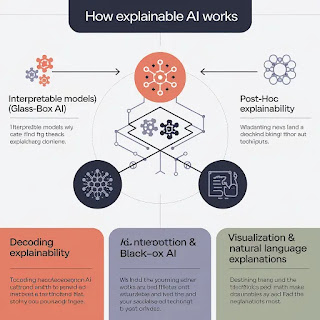Explainable AI (XAI): Making AI Decisions Transparent.
Artificial Intelligence (AI) is
transforming industries—from healthcare and finance to self-driving cars and
customer service. But as AI systems grow more complex, a critical question
arises: How do these models make decisions? If an AI denies a loan application,
misdiagnoses a disease, or rejects a job candidate, can we trust its reasoning?
This is where Explainable AI
(XAI) comes in. XAI aims to peel back the "black box" of AI, making
its decision-making process transparent, interpretable, and trustworthy. In
this article, we’ll explore why XAI matters, how it works, real-world
applications, and the challenges it faces.
Why Explainability Matters in AI?
Imagine a doctor using an AI
system to diagnose cancer. The AI recommends aggressive treatment, but when
asked why, it simply responds: "Trust me." Would the doctor—or the
patient—accept that blindly? Probably not.
The Black Box Problem
Many advanced AI models,
particularly deep learning systems, operate as black boxes—they take inputs,
process them through hidden layers, and produce outputs without revealing their
reasoning. While they often perform with high accuracy, their lack of
transparency raises concerns:
·
Accountability:
If an AI makes a harmful decision, who is responsible?
·
Bias
& Fairness: How do we know if the AI is discriminating against certain
groups?
·
Regulatory
Compliance: Laws like the EU’s GDPR grant users the "right to
explanation" for automated decisions.
·
User
Trust: People are more likely to adopt AI if they understand how it works.
A 2022 survey by Deloitte found
that 67% of business leaders consider explainability a top priority when
deploying AI. Without it, AI adoption faces resistance—especially in
high-stakes fields like medicine, law, and finance.
How Explainable AI Works?
XAI isn’t a single technique but a collection of methods designed to make AI decisions interpretable. These approaches vary depending on the AI model:
1. Interpretable
Models (Glass-Box AI)
Some AI models are inherently
explainable because of their simple structure:
·
Decision
Trees: Follow a flowchart-like structure where each decision is traceable.
·
Linear
Regression: Shows how input features directly influence the output.
·
Rule-Based
Systems: Use predefined logical rules (e.g., "If credit score >
700, approve loan.").
While these models are
transparent, they often lack the complexity needed for high-performance tasks.
2. Post-Hoc
Explainability (Decoding Black-Box AI)
For more complex models like
neural networks, we use techniques to interpret decisions after the fact:
·
Feature
Importance: Identifies which inputs most influenced the decision (e.g.,
"Your loan was denied due to low income and high debt.").
· LIME (Local Interpretable Model-Agnostic Explanations): Creates a simplified version of the model to explain individual predictions.
·
SHAP
(SHapley Additive exPlanations): Borrows from game theory to quantify each
feature’s contribution to the outcome.
For example, if
an AI rejects a mortgage application, SHAP could reveal that credit history had
a 50% impact, while employment status contributed 30%.
3. Visualization
& Natural Language Explanations
Humans understand visuals and
narratives better than raw data. XAI tools often generate:
·
Saliency
Maps: Highlight which parts of an image a neural network focused on (used
in medical imaging).
·
Counterfactual
Explanations: Show what small changes would reverse a decision (e.g.,
"Your loan would be approved if your income increased by $5,000.").
Real-World Applications of XAI
1. Healthcare:
Trusting AI Diagnoses
In 2020, an AI model at Mayo Clinic predicted patient heart risks with 90% accuracy—but doctors hesitated to use it without understanding why. By applying XAI, researchers found the model relied on subtle ECG patterns invisible to humans, increasing physician trust.
2. Finance: Fair
Lending & Fraud Detection
Banks like JPMorgan Chase use XAI
to explain credit decisions, ensuring compliance with fair lending laws.
Similarly, AI fraud detection systems must justify why a transaction was
flagged—preventing false accusations.
3. Criminal Justice:
Reducing Algorithmic Bias
ProPublica’s investigation
revealed that COMPAS, an AI used in court sentencing, was biased against Black
defendants. XAI techniques later exposed flaws in its training data, leading to
reforms.
4. Autonomous
Vehicles: Explaining Life-or-Death Decisions
If a self-driving car swerves to
avoid a pedestrian, regulators and passengers need to know why. XAI helps
engineers audit these decisions for safety and ethical compliance.
Challenges & Limitations of XAI
Despite its promise, XAI isn’t a magic bullet:
·
Trade-Off
Between Accuracy & Explainability: The most accurate AI models (e.g.,
deep learning) are often the least interpretable.
·
Over-Simplification:
Explanations might miss nuanced reasoning, leading to false confidence.
·
"Explanation
Washing": Some companies use XAI as a PR tool without addressing
underlying biases.
Experts like Cynthia Rudin (Duke
University) argue that we should prioritize interpretable models from the start
rather than trying to explain black-box systems retroactively.
The Future of Explainable AI
As AI becomes more embedded in society, the demand for transparency will only grow. Key future trends include:
·
Regulatory
Push: Governments are mandating XAI in sectors like healthcare and finance.
·
Human-AI
Collaboration: Tools that let users interrogate AI in real time.
·
Self-Explaining
AI: Next-gen models designed to be inherently interpretable without
sacrificing performance.
Conclusion: Transparency Builds Trust
AI won’t reach its full potential
unless people trust it. Explainable AI bridges the gap between cutting-edge
technology and human understanding—ensuring that AI decisions are fair,
accountable, and justifiable.
Whether you’re a doctor, a loan
officer, or just someone curious about AI, XAI empowers you to ask: "How
did you arrive at that decision?"—and get a meaningful answer.
As we move forward, the goal
isn’t just smarter AI—it’s AI we can understand, question, and ultimately,
trust.
Would you like a deeper dive into any specific XAI technique or industry application? Let me know in the comments!






